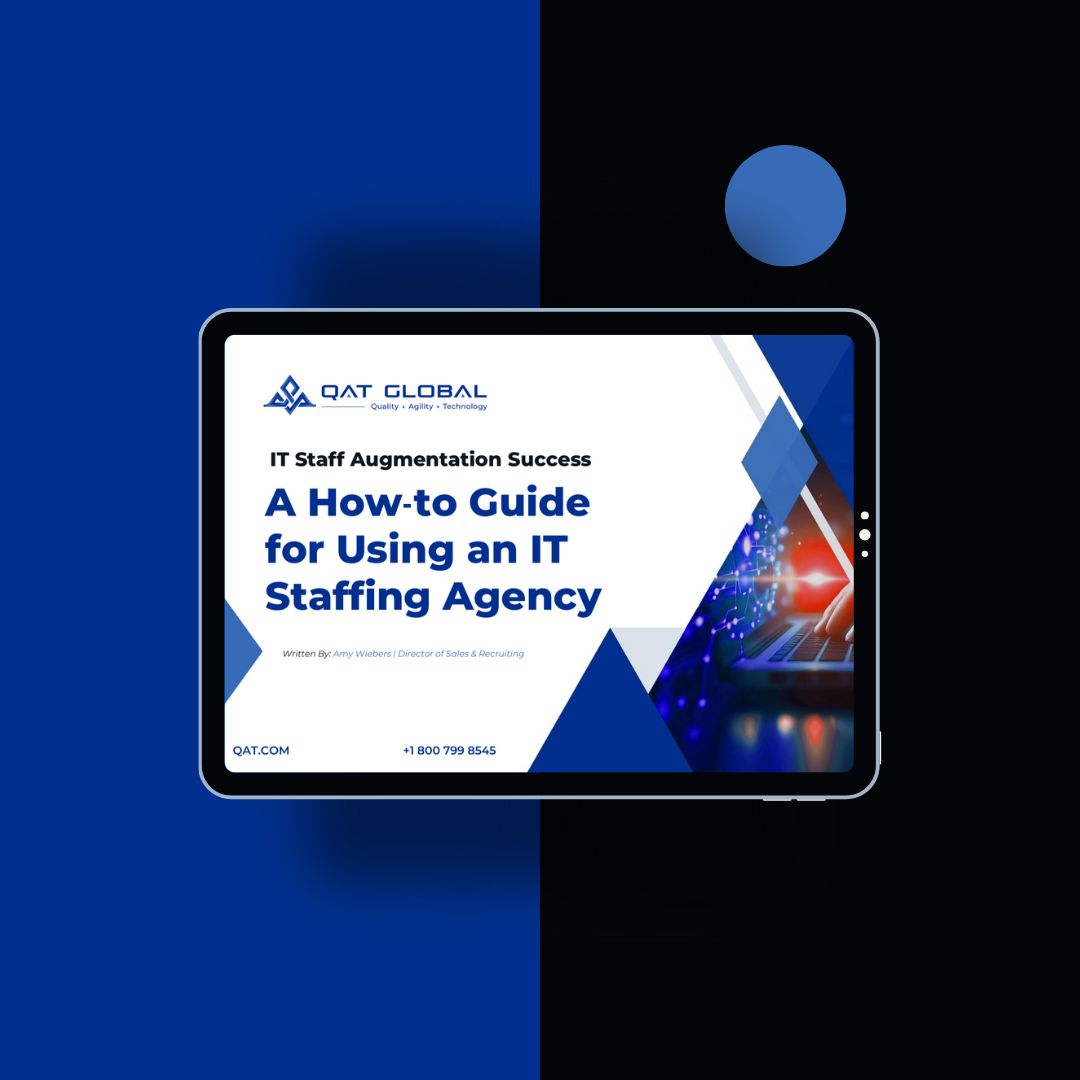The Future of Tech is Here—Primed for Disruption
The technology emerging today used to be science fiction—now it’s the foundation for competitive advantage. It’s changing how software is built, how systems operate, and how enterprises scale.
This isn’t just theory.
- AI agents that act autonomously across systems.
- Quantum computing is threatening to flip encryption standards upside down.
- Digital twins, edge computing, and neuromorphic chips are powering real-time intelligence.
These emerging technologies are changing the rules. Not next quarter or next year. Right now.
Leaders looking to take advantage of this tech aren’t waiting. The tech is being deployed and used now to solve real problems, unlock new revenue, and build software that gives them a strategic edge.
It’s more than hype about the latest tech. It’s a call to build smarter, faster, and future-ready.
Let’s break down the 9 most disruptive emerging technologies impacting enterprise software today—with real use cases and strategic takeaways that go way beyond buzzwords.
If you’re serious about staying competitive, this isn’t just worth reading. It’s a roadmap to what’s next.
What Are Emerging Technologies?
Signals of what’s next—and tools you can act on now.
Emerging technologies are innovations that haven’t hit mass adoption yet—but are already creating real impact inside high-performing enterprises. These forward-thinking solutions have been created to solve high-stakes challenges, reshape architectures, and force leaders to think differently about what’s possible.
Here are the three traits that define emerging tech:
It works—in real enterprise environments, not just labs or pitch decks.
It scales—from prototypes to production, with measurable outcomes.
It shifts strategy—altering how you architect, hire, invest, and compete.

Tech #1 – AI Agents (Autonomous AI Systems)
Software with a mind of its own.
AI agents are autonomous systems that can plan, reason, and act on your behalf. Enterprises have already begun implementing this emerging technology, and it’s becoming a transformative force in how work gets done.
More than just an upgraded chatbot, AI agents are rewriting how teams operate — from triaging support tickets and managing workflows to coordinating backend systems and triggering real-time decisions.
Why It Matters
AI agents introduce a shift that’s as operational as it is architectural. They allow you to:
- Automate full workflows—not just single tasks
- Act across systems via APIs, SaaS tools, and internal platforms
- Scale execution without scaling headcount
They’re not only supporting your team—this tech is becoming a part of it.
Real-World Use Cases
- IT Ops – Agents detect system anomalies, restart services, file reports, and notify humans only when needed.
- Customer Service – Autonomous agents handle requests, update systems, and escalate exceptions – all without human handoffs.
- Compliance – Agents monitor activity across platforms and flag potential violations before they become problems.
What This Means for Application Development
AI Agents are more than automation 2.0. This emerging tech could be a complete shift in how enterprise software functions.
Here’s how this changes the way you build:
- Your apps are no longer passive—they need to be agent-ready, built for systems that act without human input.
- Security, observability, and governance models must evolve—because when code acts autonomously, audits become mandatory.
- DevOps meets AIOps (AI-augmented IT operations)—your architecture will need to support agent orchestration, real-time feedback loops, and dynamic triggers.
The Risk If Ignored
Your competitors aren’t hiring more hands. They’re deploying more intelligence. Ignore this trend, and you risk:
- Getting outpaced by faster, leaner ops teams.
- Losing talent to organizations offering smarter systems.
- Burning budget on repetitive work that agents can handle in seconds.
AI agents open the door to more intelligent, responsive, and scalable operations. By designing systems that can act, adapt, and improve on its own, you wouldn’t just be keeping up—you’re creating space for your teams to focus on driving your success.

Tech #2 – Quantum Computing
The next leap in enterprise problem-solving is already taking shape.
Quantum computing isn’t here to replace your current systems—it’s here to expand what’s possible.
From modeling financial risk to accelerating pharmaceutical breakthroughs, quantum is unlocking a class of problems traditional computers were never built to solve. While this emerging technology hasn’t hit the mainstream yet, enterprise leaders are already exploring ways to integrate quantum thinking into today’s architecture.
The best part? You don’t need to be first—you just need to be ready. That’s because the moment this emerging tech scales, the advantage will go to those who planned for it.
Why It Matters
Quantum flips the rules of computing. Instead of processing data one bit at a time, quantum machines evaluate multiple outcomes at once—enabling massive parallelism for complex problem-solving.
That’s real-world disruption across:
- Encryption – Quantum can break today’s standards (RSA, ECC) in hours, not years, according to the University of Maryland in their article “Quantum Computing – How it Changes Encryption as We Know It.”
- Optimization – The financial models, route logistics, and scheduling algorithms that used to require supercomputers? Quantum could do them in minutes.
- Simulation – Drug discovery, materials science, and AI model training could be accelerated by magnitudes, leading to quicker innovation.
Real-World Use Cases
- Finance – Risk modeling, rebalancing, and fraud detection built on quantum-powered simulations.
- Transportation & Logistics – Global routing and fulfillment operations tuned in real time—down to the traffic light.
- Pharma – Protein folding and chemical interaction simulations that used to take weeks could now happen in hours.
What This Means for Application Development
You won’t need to build quantum apps tomorrow, but the architecture you design today needs to survive what quantum will disrupt.
Here’s how this changes the way you build:
- Post-Quantum Encryption Planning – Start inventorying what apps hold sensitive data long-term. NIST states that the Secretary of Commerce has approved three FIPS (Federal Information Processing Standards) for post-quantum cryptography, including lattice-based and hash-based algorithms for encryption that are safe from quantum attacks.
- Hybrid Cloud + Quantum Integration – Most early use cases will access quantum computing via APIs. That means your architecture must be interoperable, designed for external orchestration, and have modular pipelines.
- Modeling and Simulation as a Service (MSaaS) – Leading innovators are investing in creating services now that use simulations, combinatorics, and probabilistic modeling to identify bottlenecks for improved decision-making and training.
Being prepared for Quantum isn’t about flipping your stack tomorrow. It’s about strengthening your foundation today.
The Risk If Ignored
The day quantum breaks your encryption won’t come with a warning. Ignore it, and you risk:
- Legal liability for exposed data
- Security debt that can’t be patched overnight
- Falling behind in industries where optimization becomes the new differentiator
Quantum computing isn’t a far-flung tech fantasy. It’s a strategic deadline with an incredible upside—if you’re ready.

Tech #3 – Extended Reality (XR: AR/VR/MR)
Enterprise software in the third dimension.
Extended Reality (XR) has primarily been used for entertainment purposes for years now. But its purpose has shifted, and it is now being used to solve real problems for real enterprises right now.
Think of AR (Augmented Reality) headsets guiding field workers through diagnostics.
VR (Virtual Reality) training simulations that reduce onboarding time.
MR (Mixed Reality) overlays that give frontline teams live, hands-free access to complex systems.
Why It Matters
XR changes the interface of enterprise software—from flat screens to immersive spaces. It gives teams:
- Hands-free access to real-time data and instructions
- Spatial awareness for complex tasks and simulations
- Remote collaboration that’s more than just another video call
For workspaces where time, safety, and accuracy matter, XR is gaining a competitive edge.
Real-World Use Cases
- Manufacturing – Techs can wear AR headsets showing step-by-step instructions overlaid on the actual equipment, reducing errors and training time.
- Healthcare – Healthcare professionals can train on virtual patients with dynamic symptoms.
- Energy – Smart helmets show pressure readings, pipe schematics, and hazard alerts—no clipboards or radios necessary.
What This Means for Application Development
XR isn’t just a UI upgrade. This emerging technology has started a transformation in how users interact with software and how software will interact with the real world.
Here’s how this changes the way you build:
- You’re Designing for Space, Not Screens – Apps must support 3D interfaces, spatial navigation, and gesture/voice interaction.
- Data Must Flow in Real Time – XR apps depend on ultra-low-latency streams of context-rich data. That requires edge computing, reliable connectivity, and fast, flexible APIs.
- Platform Interoperability Is Non-Negotiable – Your apps will need to work across AR glasses, VR headsets, mobile devices, and traditional screens—often all at once.
The Risk If Ignored
XR adoption is speeding up as businesses are looking to enhance efficiency and safety. Fail to explore it, and you risk:
- Higher incident rates due to a lack of field visibility
- Reduced performance in frontline roles
- Losing contracts to tech-enabled competitors who deliver faster, smarter, and safer
XR is no longer a novelty—it’s the next evolution in enterprise user experience. It will shape how your software will be seen, used, and expected to perform.

Tech #4 – Digital Twins
When your systems speak, Digital Twins help you listen—and predict what they’ll say next.
No longer a theory, Digital Twins are becoming the command centers of modern operations. They blend both physical and digital data into a single, actionable source of truth.
It’s not just about visibility. It’s about foresight, and the difference between reacting late and preventing a problem entirely.
Why It Matters
A Digital Twin is a real-time, continuously updated model of a physical system. This emerging technology’s value goes way beyond visualization.
It lets teams:
- Simulate “what if?” before “now what?”
- Spot issues before they become outages
- Optimize workflows and assets with data, not assumptions
When done right, digital twins can become a buffer. This technology allows for strategic testing on how a decision will impact your business rather than taking unnecessary risks.
Real-World Use Cases
- Manufacturing – Simulate assembly line changes in software before touching machinery. Predict maintenance before breakdowns.
- Healthcare – Build a digital twin of a hospital to manage flow, staffing, and resource allocation in emergencies.
- Logistics – Simulate delivery scenarios under changing weather, traffic, and demand—then adjust on the fly.
What This Means for Application Development
Digital Twins aren’t a feature—they’re an architecture. This emerging tech’s architecture needs smart, responsive software at its core.
Here’s how this changes the way you build:
- Your Apps Must Ingest, Interpret, and Act on Real-Time Data – This is stream-first thinking. Your platform needs to handle telemetry, time-series data, and event-driven workflows by default—not as an add-on.
- APIs Must Be Open and Modular – Twins often pull data from dozens of systems. Your stack must be interoperable, composable, and designed for distributed environments.
- Security, Audit, and Access Must Scale with Twin Complexity – As more stakeholders use digital twin data to make critical decisions, your software must control access, track actions, and preserve trust.
Used correctly, digital twins are going to become more than a “nice to have.” For complex, high-stakes operations, it will become how you maintain clarity for the future of your business.
The Risk If Ignored
Flying blind is risky. Failing to invest in Digital Twin infrastructure means:
- No predictive capability for asset performance or failure
- Missed optimization opportunities across operations
- Fragmented decision-making based on stale data
Digital Twins don’t just reflect your systems. They help you understand, improve, and control them.

Tech #5 – Edge Computing + 5G
The Cloud Can’t Reach Everywhere—But Your Software Still Has To.
The days of relying solely on centralized cloud infrastructure are over. As software becomes further integrated into physical environments, speed, reliability, and location awareness become more critical.
That’s where the powerful combo of edge computing and 5G comes in.
Together, these technologies unlock the ability to process data where it’s generated, respond to events as they happen, and run software that’s always on, even when connectivity isn’t. It’s not just about faster apps—it’s about smarter systems that operate with precision, autonomy, and resilience.
Why It Matters
Edge computing moves processing power closer to the action—to the shop floor, the field, the warehouse, or the street.
5G brings ultra-low latency and high reliability to move that data faster than ever.
Together, they allow:
- Real-time decisions where connectivity is limited
- Lower latency for critical apps that can’t afford delay
- Always-on operations even when networks go down
Real-World Use Cases
- Manufacturing – Edge devices detect anomalies and trigger fail-safes in milliseconds. This can be done without the delay of Round-Trip Time (RTT), where data is sent to the cloud, processed, and then sent back.
- Healthcare – Bedside monitors process patient vitals and issue alerts without relying on network speed and remote data centers.
- Autonomous Systems – Drones, robots, and AVs can make split-second decisions on-device thanks to edge computing. Combined with 5G, these systems can process data locally, interpret visual inputs with AI, and communicate with surrounding infrastructure in real time—improving safety, responsiveness, and transportation efficiency without relying on the cloud.
What This Means for Application Development
Edge + 5G isn’t just an infrastructure choice. This emerging tech changes the assumptions your software is built on.
Here’s how this changes the way you build:
- Your Apps Must Operate Across Environments – While parts of your application logic will need to run locally—on devices, gateways, or field hardware—other parts must remain in the cloud. That means designing software that can intelligently split workloads, sync data in real time, and continue functioning even when connectivity drops.
- Latency Becomes a Design Constraint – If your app responds in seconds, it may already be too late. You’re now designing for sub-second performance, bandwidth prioritization, and failover strategies.
- DevOps Must Expand to the Edge – Edge computing introduces a distributed layer of devices, sensors, and on-site systems that need updates, monitoring, and secure orchestration. That means extending DevOps practices to support real-time telemetry, remote debugging, and CI/CD.
You’re no longer building for a single environment. You’re building a network of micro-environments, each with its constraints and opportunities.
The Risk If Ignored
The cloud still plays a critical role—but relying on it alone for real-time performance, resilience, or compliance is no longer going to be enough. If your architecture doesn’t account for what needs to happen locally, you’ll face limitations in environments where speed, uptime, and autonomy matter most.
Risks include:
- Application lag in latency-sensitive environments
- Downtime during connectivity disruptions
- Cost spikes from excessive cloud usage
For software that needs to react in real-time, Edge computing is a critical piece of the formula.

Tech #6 – Implanted Technologies
Your software isn’t just on the user’s desktop—it’s syncing with them.
Implanted and body-integrated technologies have become more than props for a science fiction movie. They’re already being implemented to monitor vitals, authenticate users, detect fatigue, and enable real-time decision-making at the human level.
These systems create a constant feedback loop between the body and software—expanding the definition of what it means to be connected.
Why It Matters
Emerging implanted tech unlocks always-on intelligence. It allows enterprise systems to:
- Monitor physical states and respond instantly
- Authenticate users based on location, biometrics, or physiological data
- Power hands-free, heads-up interfaces in high-risk or high-precision environments
The shift isn’t just personal – it’s operational. Your team is becoming part of the platform.
Real-World Use Cases
- Healthcare – Continuous glucose monitors and neurostimulators can stream live vitals into monitoring platforms, enabling real-time alerts and AI-driven treatment adjustments.
- Industrial Work – Smart helmets can detect heat exhaustion. Wearables can track your team’s posture and fatigue—then alert them before an injury happens.
- Neurotech – Brain-computer interfaces (BCIs) are already being tested in clinical environments to help users interact with systems using neural signals. These early use cases are laying the foundation for hands-free, intent-driven software control.
What This Means for Application Development
Implanted tech makes humans are an active data source and this will stretch the imaginations of your software teams.
Here’s how this changes the way you build:
- Context Becomes a Trigger – Apps can’t wait for clicks—they must respond to real-world cues instantly. Software must respond to real-time IoT (Internet of Things) signals from sensors, wearables, and implants from the user and adjust accordingly.
- Authentication Becomes Passive and Continuous – Instead of logging in with passwords or badges, users are verified automatically through biometrics and proximity-based signals. Your software must support these ambient identity methods to keep access secure without interrupting the user experience.
- Interfaces Must Leave the Screen – Heads-up displays, smart rings, and gesture-based inputs demand interface minimalism—software must work with fewer inputs, faster feedback, and non-traditional UIs.
You’re not just designing for users. You’re designing for human-machine integration.
The Risk If Ignored
This tech goes beyond just cool gadgets and gizmos. It represents a competitive edge in human performance, safety, and systems intelligence. Consider implanted tech if your application can’t afford these risks:
- Higher incident rates in field ops and industrial roles
- Inefficient security models that frustrate users and slow workflows
- Missed opportunities in health tech, defense, and workforce optimization
You’re not just designing for users. You’re designing for human-machine integration.

Tech #7 – Micro LLMs (Local/Small Language Models)
Small AI Making Big Impact
Large language models are powerful, but they’re not always practical. Rising costs, privacy concerns, and the need for domain-specific accuracy are driving a shift away from massive cloud-based APIs toward something leaner, smarter, and more secure: Micro LLMs.
Micro LLMs are lightweight models trained specifically for speed, focus, and local control. They’re unlocking serious AI capabilities across enterprises without the risk of data exposure or ballooning API costs.
Why It Matters
Micro LLMs deliver the power of AI without the baggage. With today’s advances in model distillation (a process that shrinks large models into smaller, faster ones) and on-device inference, you can now run custom-tuned models behind your firewall, inside your app, or on edge devices.
This gives your enterprise:
- Full control over data privacy and sovereignty
- Faster inference and lower latency
- Use-case-specific tuning for compliance, industry terms, and team workflows
- Huge cost savings over commercial LLM APIs
These aren’t just miniature versions of popular Gen-AI products. They’re high-performance assistants built for your stack, your security, and your speed. Built to work with your data and systems, without the unnecessary fluff of also knowing how to write poetry.
Real-World Use Cases
- Enterprise AI Assistants – Internal copilots for HR, finance, legal, or compliance teams that never send a byte outside the firewall.
- Code Intelligence – Micro LLMs embedded in dev tools for real-time code generation, refactoring, and test writing.
- QA & Documentation – Instant summarization, formatting, and content generation across internal platforms attuned to your templates and tone.
- On-Device Intelligence – Field-ready mobile apps that respond to user queries, forms, and workflows, without relying on cloud connectivity.
What This Means for Application Development
AI is becoming more than a new tool you can connect to. It’s something you embed, and that changes how you design, train, and deploy intelligent features.
Here’s how this changes the way you build:
- Fine-Tuning Pipelines – Your team must be ready to train and adapt models using internal data, safely and responsibly.
- Inference Optimization – Expect to architect for smaller models that can run on CPUs, mobile chips, or lightweight edge devices.
- Privacy-First Architecture – With micro LLMs, you keep full custody of your data, which means compliance, security, and governance are now on your terms.
- Custom Integration Opportunities – These models won’t come with a dashboard. Your development team will build the UI, workflow integration, and domain-specific logic that makes them indispensable.
The Risk If Ignored
Consider micro LLM’s to avoid these wide-spread risks:
- Cost creep from API-heavy LLM usage
- Vendor lock-in from hosted AI platforms
- Data risk from sending sensitive info off-premises
Micro LLMs aren’t a compromise. They’re the next evolution in enterprise AI, redefining what it means to move fast, stay secure, and build smart.

Tech #8 – Spatial Computing
Software Is About to Get a Lot More Dimensional
Spatial computing is where real-world space meets digital capability. By merging augmented reality (AR), virtual reality (VR), mixed reality (MR), and spatial awareness, this emerging technology is causing major changes. It’s forcing teams to take another look at how they work, train, and evaluate decisions, especially for field operations, logistics, and high-stakes environments.
Why It Matters
Spatial computing turns every environment into a workspace. Whether it’s training a surgeon, guiding a field tech, or navigating a complex data model, this technology enables teams to interact with systems naturally with gestures, gaze, voice, and movement in full 3D context.
Here’s what it unlocks:
- Hands-free access to enterprise systems in real-world environments
- Real-time visual overlays on physical equipment, infrastructure, or patients
- Immersive learning and training with higher retention and faster ramp-up
- Interactive dashboards and data visualizations built for movement, not mouse clicks
Real-World Use Cases
- Immersive Training – Healthcare professionals can simulate complicated procedures and operations, or pilots can train on aviation safety, without real-world risk.
- Field Service and Maintenance – AR overlays show step-by-step repair instructions on actual equipment, reducing downtime and errors.
- Spatial Dashboards – Navigate logistics networks or environmental systems in 3D to uncover insights that 2D dashboards can’t reveal.
What This Means for Application Development
Spatial computing isn’t just a feature — it’s a new paradigm. And that means enterprise software must be reimagined from the interface down.
Here’s how this changes the way you build:
- 3D and Spatial UX – You’re not designing screens. You’re designing environments. Expect to build gesture-based, voice-controlled, and gaze-directed interfaces.
- Cross-Platform XR Support – Your applications must perform across AR headsets, VR environments, tablets, and desktops, with seamless transitions.
- Real-Time Data Integration – Spatial experiences rely on live data streams. Your software must sync digital twins, IoT sensors, or workflow logic instantly and accurately.
- Hardware-Aware Engineering – Different devices mean different capabilities. Developers will need to account for sensor inputs, environmental mapping, battery life, and processing limitations.
The Risk If Ignored
For some specialized operations, using spatial computing can give you a competitive advantages and you avoid these risks:
- Falling behind in immersive training and field operations
- Offering outdated UX in environments that demand speed, safety, and precision
- Missing major competitive wins in industries where hands-free, high-context access could become the standard
This isn’t a gaming feature. It’s a business interface. The leaders who build for it now will define the new standard for how software feels and interacts, not just how it functions.

Tech #9 – AI-Generated Design as Code (DaC)
Your Design Transformed into Your Code
AI-Generated Design as Code takes what used to be a handoff and turns it into a launchpad.
With the help of AI, static mockups are transformed into clean, scalable, and framework-specific code—ready to plug directly into your application. Frontend components, layout logic, and even styling conventions are generated based on your system’s standards and design tokens.
It’s not about skipping development—it’s about eliminating bottlenecks, reducing rework, and accelerating your entire build cycle.
Why It Matters
DaC is AI-powered development acceleration. This emerging technology is not just for developers but for product owners, designers, and tech leads who need to ship smarter, faster, and with less friction.
It allows teams to:
- Convert design layouts directly into functional UI components.
- Generate consistent, reusable code using established design systems and tokens.
- Produce clean, maintainable code that aligns with your architecture and standards—automatically.
Real-World Use Cases
- Enterprise Dashboards – Convert design systems into production-ready dashboards with dynamic elements, responsive logic, and integrated state management.
- Design System Portability – Convert designs into AI-generated code that works across frameworks like React, Angular, Flutter, and Vue with consistent styling and behavior.
- Internal Tooling – Rapidly build MVPs of admin portals, workflow UIs, or customer-facing apps without burning weeks on setup or basic scaffolding.
What This Means for Application Development
DaC isn’t just about writing code faster—it’s about closing the gap between vision and execution. By transforming design intent directly into structured, scalable code, DaC removes the delays, guesswork, and inefficiencies that often slow down delivery.
Here’s how this changes the way you build:
- Design Becomes Code-Ready – Wireframes, component libraries, and design tokens can now be transformed into real, production-grade code. That means less rework and clearer alignment from day one.
- Iteration Moves Into Real Time – Stakeholders can make content, layout, or UI changes and see updates reflected instantly in the code.
- Code Quality Is Customizable and Consistent – AI is trained to match your team’s standards so the output is clean, reusable, and enterprise-grade from the start.
The Risk If Ignored
It is possible, you no longer have to build from scratch?
Consider this on your next big effort to avoid:
- Burning dev hours on the layout instead of logic
- Losing top talent to teams that build smarter, not harder
- Introducing errors between design and implementation that AI workflows would’ve caught
DaC isn’t about replacing your team. It’s about unlocking their speed, accuracy, and creative bandwidth.
Build Bold. Lead Smart. Move Now.
These nine emerging technologies are more than just hype. They’re technologies that businesses are already implementing and reshaping how software is built, scaled, and experienced.
Staying ahead of the curve doesn’t mean buying a tool or chasing the latest acronym.
It means building smarter, faster, and more intentionally—with a partner who knows how to turn your vision into a custom-built solution that drives your success.
That’s where QAT Global comes in.
We don’t just track emerging tech—we build with it. We design and develop custom software solutions that put these technologies to work in your environment, for your goals, and on your timeline.
Stop watching tech evolve around you and start building what’s next.
Schedule a consultation with a QAT Global technology expert today and discover how we can propel your business to new heights!
QAT Global | Your Success is Our Mission!
- The Future of Tech is Here—Primed for Disruption
- Tech #1 – AI Agents (Autonomous AI Systems)
- Tech #2 – Quantum Computing
- Tech #3 – Extended Reality (XR: AR/VR/MR)
- Tech #4 – Digital Twins
- Tech #5 – Edge Computing + 5G
- Tech #6 – Implanted Technologies
- Tech #7 – Micro LLMs (Local/Small Language Models)
- Tech #8 – Spatial Computing
- Tech #9 – AI-Generated Design as Code (DaC)
- Build Bold. Lead Smart. Move Now.
















